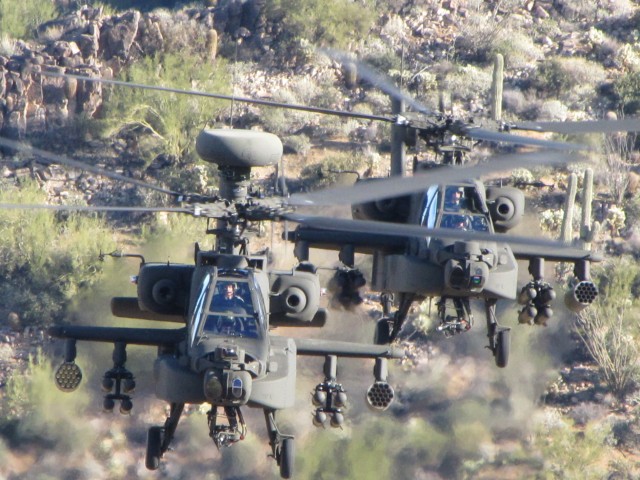NASHVILLE, Tenn. (Army News Service, April 22, 20110) -- Apache attack helicopters will soon field a new, high-tech Ground Fire Acquisition System, which uses cameras and infrared sensors to instantly identify the source location of ground fire, service officials said.
"GFAS (Ground Fire Acquisition System) detects ground fire. It allows us to take information about incoming fire, get our sensors on it and identify and prosecute ground targets," said Maj. Justin Highley, Assistant product manager for the Longbow Apache.
The infrared sensors built into the GFAS system detect muzzle flashes from the ground, allowing Apache pilots to get their sensors on potential targets and immediately know the location, and distance of ground fire, Highley explained.
Next spring, 1-101 Aviation out of Fort Campbell will become the first unit equipped with GFAS, he said.
The cameras on the aircraft detect the muzzle flash from ground fire - and move the information through an Aircraft Gateway Processor into the cockpit so pilots will see an icon on their display screen, said Lt. Col. Jeff Johnson, product manager, Longbow Apache.
"The beauty of this system is that we are not changing the aircraft software. We are not adding displays. It's integrated through an Aircraft Gateway Processor," he said.
Upon receiving the information about the ground fire on their display screens, the aircraft crew can move their Modernized Target Acquisition Designation Sight/Pilot Night Vision Sensors, or MTADS/PNVS, onto the target at the touch of a button, Johnson said.
"The crew sees the point of origin where the muzzle flash was detected,"
he said. "It is not just about the aircraft, but about getting information to guys on the ground who are in the fight. Apache has led the way for other platforms with net-centric operations and situational awareness."
The GFAS effort - called an Early User Evaluation - has undergone a range of key tests at places such as Mesa Ariz., and Yuma Proving Ground, Ariz., Johnson explained.
Pending successful outcome of the User Evaluation, the Apache Program Manager will look at expanding GFAS' capabilities, including integrating the technology with Blue Force Tracker display screens, Johnson said.
"Crews often return from missions in Afghanistan with small-arms damage to the aircraft," Johnson explained. "GFAS is an offensive targeting system. It is not a piece of aircraft survivability equipment. It helps us fulfill our mission of closing with and destroying the enemy."
"How many of those forces who've been trying to shoot down our helicopters with small arms would have been eliminated by now if we had been able to pinpoint their locations'" Johnson said. "A recent historical example of why we need GFAS is the battle for Camp Keating in October 2009. We lost eight Americans and and had 24 wounded in one day because we could not locate an attacking enemy during the daytime."
"Medevac could not extract our wounded until (9 p.m.), when it was dark and those small-arms weapons had finally been located and destroyed -- after 8 or 9 hours of fighting," Johnson said. "To me, that's unacceptable. Our Soldiers deserve better."
Related Links:
Army building first Block III Apache
Army.mil Fact Files: Apache Helicopter
Army.mil: Science and Technology News
STAND-TO!: The Army Modernization Strategy - Second Line of Effort
Office of the Assistant Secretary of the Army for Acquistion, Logistics and Technology - ASA(ALT)


Social Sharing